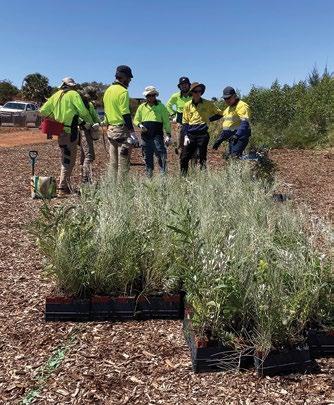
3 minute read
Plants established
Greening Australia and AstraZeneca team members working together to plant trees on a 2022 project site in TAS. Photo credit Adam Gibson.
2022 IMPACT
Advertisement
4.2 million native plants established
Scaling up to establish millions of plants for Australia
Over the 2022 planting season, we established an incredible 3.7 million native plants for two major partners – AstraZeneca and Officeworks — across an impressive 3,806 hectares. To enable rapid upscaling from 2021, we mobilised the nursery industry to grow tens of thousands of seedlings and sourced well over 1,000 kilograms (kg) of native seed across the country, re-engineered and increased capacity of our direct seeding fleet and expanded our landholder engagement enabling widespread restoration. With great conditions for germination and growth over the year, our future monitoring and maintenance activities aim to show high levels of establishment by 2025.
Bringing trees to the people
In collaboration with Clouston Associates, our Nature in Cities team created a detailed concept plan for 10 hectares across Camden Council’s John Oxley Reserve in western Sydney to deliver measurable outcomes for both people and nature. With staff from Mastercard and Conservation International, over 100 community volunteers and professional planting teams installed 17,000 trees, shrubs and groundcovers at this flagship site in order to demonstrate the importance of nurturing nature in our urban landscapes. It’s wonderful to see this weed-covered hillside begin the transition to become a place purpose-built for people and nature to thrive.

Mastercard and Conservation International team members helping us plant thousands of trees at John Oxley Reserve.
Photo credit Tim Clark.
Habitat corridors and nutrient buffers in the Wet Tropics
Our Reef Aid team planted over 4,250 trees in priority wetlands and creek riparian zones in the Wet Tropics, contributing to the 54,418 trees planted under the Repair and Restoration of Priority Coastal Habitats and Wetlands Project. These trees add to other plantings creating environmental corridors and buffering sediment and nutrient run-off. 156 volunteers from local community groups came together to plant the trees and share knowledge.

Volunteers from local community groups assisting with plantings in the Wet Tropics.
Photo credit Simone Vinton.
Planting for air quality
Project LEAF (Leaf Enhanced Air Filtration) in WA's Pilbara region is an innovative project developed with BHP, Curtin University and the Town of Port Hedland, which we are proudly delivering alongside local First Nations enterprises. This large-scale urban planting project uses native vegetation barriers to reduce dust and improve air quality for the Port Hedland community, while also providing visual amenity and biodiversity co-benefits. Completed this year, Stage 1 includes 2.5 hectares of planted area, including over 7 kilometres of irrigation lines, 300 sprinklers, 100 millimetre-depth organic mulch and a whopping 80,000 native trees, shrubs and groundcovers native to the Pilbara region. Stage 2 will be delivered in 2023, continuing this important impact adjacent to the current site.

The team beginning to plant Stage 1 of the vegetation barrier in Port Hedland, WA. Visible in the background is a demonstration site for Project LEAF showing incredible growth.







